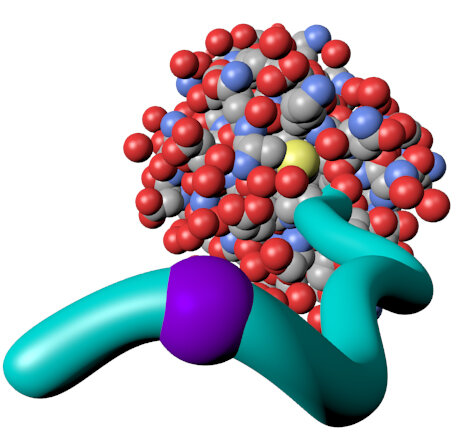

A synthetic polymer (teal tube) conjugated to a protein. The purple polymer sleeve is an informational group, the key to Konkolewicz and Page’s technique. Credit: University of Miami
A technique developed by the Associate Professors of Chemistry and Biochemistry at the University of Miami, Dominik Konkolewicz and Rick Page, can help enable faster and more efficient development of new materials for use in pharmaceuticals, biofuels and other applications.
Konkolewicz and Page’s technique uses nuclear magnetic resonance (NMR) technology to illuminate how proteins and synthetic polymers interact in chemicals known as bioconjugates.
Why are bioconjugates useful?
Proteins can be used to catalyze chemical reactions that are useful in many applications. For example, protein enzymes are used to make high-fructose corn syrup, and insulin is used to treat diabetes. But some proteins are active for a very short time or break down easily, so it is neither practical nor profitable to use them. Protein bioconjugates overcome the limitations of proteins by binding synthetic molecules, often polymers, to protein.
“Proteins have fantastic performance,” says Konkolewicz, “but there is not much flexibility in chemistry that we can put into a protein. Polymers offer a great diversity of structure and function that we can incorporate to extend the life of the protein or improve your ability to withstand extreme conditions. “
There is already a commercial development of bioconjugates, such as antibody conjugates and drugs used to treat cancer, although guidelines on how to improve the performance of these substances remain elusive.
Developing new and useful bioconjugates is often difficult and expensive because the process is traditionally based on trial and error: Scientists toss a host of candidate polymers against a proverbial wall of proteins to see what “sticks” in the form of performance improved. But just as there is no point in throwing a tennis ball against a plaster wall waiting for it to stick, there is no point in throwing certain polymers at certain proteins that are waiting for it to stick.
Accelerate development through rational design.
We understand the nature of tennis balls and drywall well enough to know that “sticking” is not a possible result of their interaction, but Page says scientists don’t always understand the nature of proteins and polymers. well enough to make similar predictions when it comes to bioconjugation.
“In many cases, we know the structure of the protein, but we don’t know the structure of the polymer. We don’t know what its shape is, where it adheres to the protein, or how the protein envelops or interacts with it,” says Page.
Konkolewicz and Page say what is needed is a set of rules that allow for the rational design of new bioconjugates. Such rules would allow chemists to observe the structure of a target protein and design a polymer molecule of the proper size, shape, and function to specifically fit.
“It would be great to be able to say, ‘Okay, here is the protein I have. These are the ways I need to stabilize it, and here are the types of polymers we can use for that,'” says Page.
The technique developed by Page and Konkolewicz is the first step to allow the establishment of this set of rules.
While previous techniques for examining protein-polymer interactions in bioconjugates relied, for example, on neutron beams (very expensive equipment available in a limited number of facilities worldwide), the Miami chemists technique uses readily available nuclear magnetic resonance (NMR) technology. The key to the technique is to place report groups on the synthetic polymers. These sets of reports act as beacons, allowing researchers to see how close a polymer is to a protein, when the bioconjugate is on an MRI instrument.
The accessibility of NMR technology is important because it greatly increases the ability of the research community to make discoveries.
“We cannot analyze all the relevant proteins ourselves,” says Konkolewicz. “We would have to live 500 years to do that. By making it accessible, we allow other groups to examine their proteins of interest: catalytic proteins, like our laboratory, or therapeutic proteins, or any kind of study. The technique provides scale.”
A breakthrough made possible by Miami’s unique environment
Fundamentally, the Konkolewicz and Page technique enables chemists around the world to collaborate in establishing a set of design rules to guide faster development of bioconjugates that are effective and affordable for use in industrial applications, including pharmaceuticals. and biofuels. That is an appropriate result for a research effort that grew out of collaboration.
Historically, it has been rare for scientists from different subfields to come together as Konkolewicz, a synthetic chemist, and Page, a biochemist. Konkolewicz and Page say their advancement is due to the fact that the University of Miami encourages collaboration and encourages exploration across a wide range of experience.
“The environment we have here in Miami, and the ability and encouragement for groups to collaborate with each other here, has really put us in the right environment to develop this innovative technique,” says Page.
Another aspect of Miami’s unique environment is the deep involvement of college students in research. Four university students from Konkolewicz Labs and Page were named authors of an article reporting on their technique, which was recently published in the Royal Society of Chemistry’s open access flagship journal. Chemistry.
New Technique Accelerates Production of Protein Nanoarmor
Kevin M. Burridge et al. Mapping protein-polymer conformations in bioconjugates with atomic precision, Chemistry (2020). DOI: 10.1039 / D0SC02200D
Provided by the University of Miami
Citation: Miami Chemists Innovative Technique Enables Design at the Chemistry and Biology Interface (2020, July 21) Retrieved July 22, 2020 from https://phys.org/news/2020-07- miami-chemists-breakthrough-technique-enables. html
This document is subject to copyright. Other than fair dealing for private study or research purposes, no part may be reproduced without written permission. The content is provided for informational purposes only.